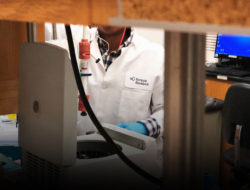Virtual reality can transport users to the ends of the Earth, the farthest reaches of the universe, and even to entirely made-up worlds in video games and movies. But what about taking us to the most basic form of our own being? Nanome, a startup helmed by four UC San Diego grads, has developed VR software that allows exploration of the very core of existence—atoms and molecules.
“We’re zooming down to the nanoscale—10 to the negative 9,” says Keita Funakawa, chief operating officer of Nanome and a member of the first class of nanoengineers at UCSD, the first university to have such a program. “That’s—to put it simply—really, really small.”
With Nanome, you can step inside strings and groups of these molecules—which could be drugs, proteins, or chemical compounds—and move them around with your hands. The platform-agnostic application allows users to design new medicines or chemicals in a virtual 3-D space, finding ideal shapes and structures for different compounds more intuitively than a traditional interface.
“Everything is made out of atoms, the entire world, and a lot of industries are going into precision nanoscale,” Funakawa says. “The problem today is, there’s just not many tools for being able to design at that scale. 2-D isn’t good, but VR is perfect for that.”
Tags: Innovation, Nanome, Tip Sheet, UCSD, Virtual Reality






























